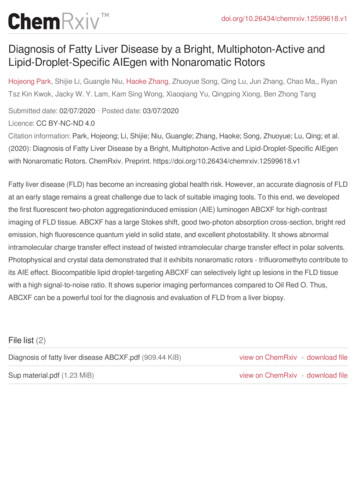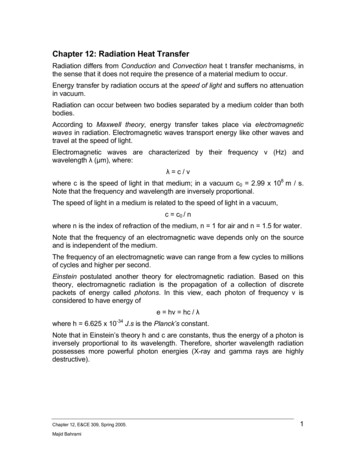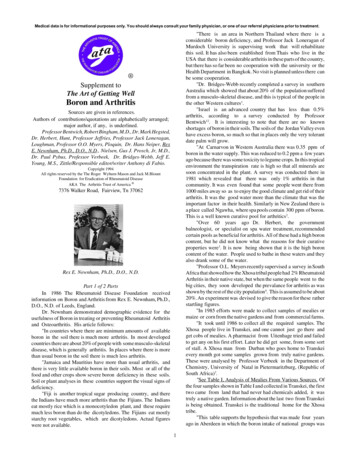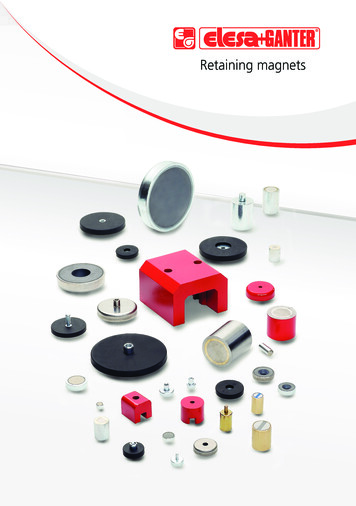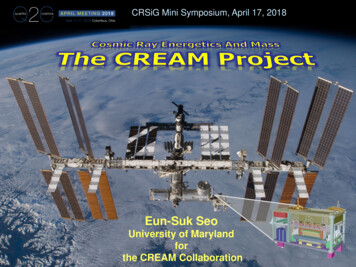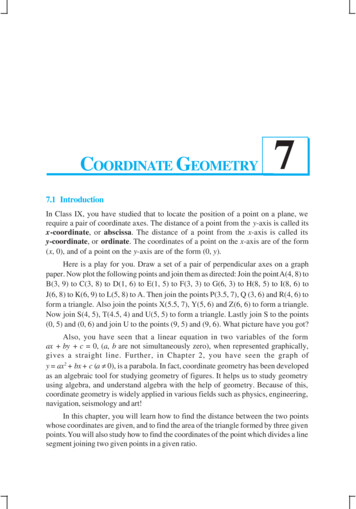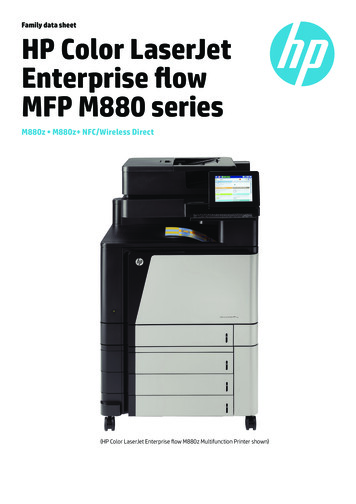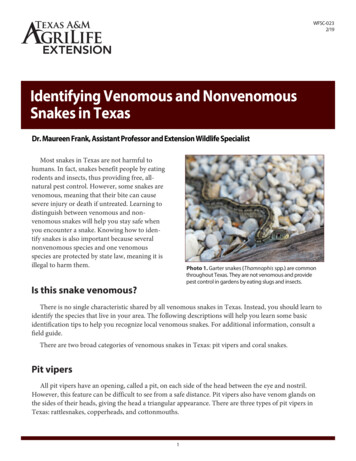
Transcription
Electronic Supplementary Material (ESI) for ChemComm.This journal is The Royal Society of Chemistry 2015Supporting Information for:The Facile Realization of RGB Luminescence based on OneYellow Emissive Four-Coordinate Boron-Containing MaterialLu Wang, Kai Wang, Houyu Zhang, Chuanjun Jiao, Bo Zou*, Kaiqi Ye, Hongyu Zhang* and YueWang
General information1,3-Diaryl- -diketone and fluorobis(pentafluorophenyl)borane was synthesized according to thereported procedure. Other starting materials were common commercial grade and used as received.The solvents for syntheses were freshly distilled over appropriate drying reagents. All experimentswere performed under a nitrogen atmosphere using standard Schlenk techniques. NMR spectra wererecorded on a Bruker AVANCE 500 MHz spectrometer with tetramethylsilane as the internalstandard. Mass spectra were recorded on a GC/MS mass spectrometer. Element analyses wereperformed on a FlashEA1112 spectrometer. UV-vis absorption spectra were recorded by aShimadzu UV-2550 spectrophotometer. Melting points were determined on a Kofler hot-stage. Theemission spectra of solutions were recorded by a ShimadzuRF-5301 PC spectrometer or aMaya2000 Pro CCD spectrometer. Differential scanning calorimetric (DSC) measurements wereperformed on a NETZSCH DSC204 instrument at a heating rate of 10 C min 1 under nitrogen.Thermogravimetric analyses (TGA) were performed on a TAQ500 thermogravimeter at a heatingrate of 10 C min 1 under nitrogen. Powder X-ray diffraction data were collected at 298K on aBruker SMART-CCD diffractometer. The absolute fluorescence quantum yields were measured onEdinburgh FLS920 using an integrating sphere. The fluorescence lifetimes were measured onEdinburgh FLS920 using a time-correlated single-photon (TCSPC) module.Scheme S1 Synthetic procedure of boron compounds 1.F5OF5 BOO OH(C6F5)2BF OEt2THF, refluxNMe2Me2N1 (71%)Synthesis of boron compounds 1(C6F5)2BF·OEt2 (4.13 mmol) was added to a solution of one (3.75 mmol) in THF under nitrogen. The mixture was heated to reflux for12 h. After cooling, the produced precipitates were filtered and recrystallized from CH2Cl2/MeOH1:3 to yield the pure boron products.Data of compound 1. Yields: 71%. Mp: 248 250 C. 1H NMR (CDCl3, 500 MHz, ppm): δ 8.10 (t, J 10.0 Hz, 4 H), 7.62 (t, J 5.0 Hz, 1 H), 7.52 (t, J 10.0 Hz, 2 H), 6.96 (s, 1 H), 6.80 (d, J 10.0Hz, 2 H), 3.18 (s, 6 H). 13C NMR (CDCl3, 125 MHz, ppm): δ 180.63, 177.83, 155.41, 149.18,147.25, 141.13, 139.14, 138.04, 136.09, 133.79, 133.11, 132.26, 128.94,128.37,111.52,92.09,40.17. MS m/z: 611.28 [M ] (calcd: 611.11). Anal.Calcd (%) for C29H16BF10NO2: C, 56.98;H, 2.64; N, 2.29; Found: C, 57.16; H, 2.79; N, 2.34.
High-pressure experimentsThe tiny crystal was placed in the hole(diameter: 200 mm) of a T301 steel gasket, A silicone oil was used asa pressure transmit medium (PTM). In situ steady-state PL measurement under high pressure wereperformed on a Ocean Optics QE65000 spectrometer in the reflection mode. The 355 nm line of violet diodelaer with a spot size of 20 mm and a power of 10 mW was used as the excitation source. The diamond anvilcell (DAC) containing the sample was put on Nikon fluorescene microscope to focus the laser on the sample.Optical photographs of the compressed samples were obtained using an imaging camera (Canon EOS 5DMark II) equipped on the fluorescence microscope.Computational details.Ab initio calculations were carried out with the Gaussian 09 program.S1 Geometry at ground state wasoptimized with the density functional theory (DFT) using the B3LYP functional and 6–31G** basis set. Thesingle point energy calculation was performed in the crystal state for 1OC and 1RC. The vertical excitationswere performed with time-dependent density functional theory (TD-DFT) at the same level of theory byiteratively solving 20 states for 1OC and 1RC.Single Crystal StructureSingle crystal X-ray diffraction data were collected on a Rigaku RAXIS-PRID diffractometer using the ωscan mode with graphite-monochromator Mo Kα radiation. The structures were solved with direct methodsusing the SHELXTL programs and refined with full-matrix leastsquares on F2. Non-hydrogen atoms wererefined anisotropically. The positions of hydrogen atoms were calculated and refined isotropically. CCDC1037296 and 1037297 contains the supplementary crystallographic data for this paper. These data can beobtained free of charge from The Cambridge Crystallographic Data Centre viawww.ccdc.cam.ac.uk/data request/cif.S1 Gaussian 09, Revision D.01, M. J. Frisch, G. W. Trucks, H. B. Schlegel, G. E. Scuseria, M. A. Robb, J.R. Cheeseman, G. Scalmani, V. Barone, B. Mennucci, G. A. Petersson, H. Nakatsuji, M. Caricato, X. Li, H.P. Hratchian, A. F. Izmaylov, J. Bloino, G. Zheng, J. L. Sonnenberg, M. Hada, M. Ehara, K. Toyota, R.Fukuda, J. Hasegawa, M. Ishida, T. Nakajima, Y. Honda, O. Kitao, H. Nakai, T. Vreven, J. A. Montgomery,Jr., J. E. Peralta, F. Ogliaro, M. Bearpark, J. J. Heyd, E. Brothers, K. N. Kudin, V. N. Staroverov, R.Kobayashi, J. Normand, K. Raghavachari, A. Rendell, J. C. Burant, S. S. Iyengar, J. Tomasi, M. Cossi, N.Rega, J. M. Millam, M. Klene, J. E. Knox, J. B. Cross, V. Bakken, C. Adamo, J. Jaramillo, R. Gomperts, R.E. Stratmann, O. Yazyev, A. J. Austin, R. Cammi, C. Pomelli, J. W. Ochterski, R. L. Martin, K. Morokuma,V. G. Zakrzewski, G. A. Voth, P. Salvador, J. J. Dannenberg, S. Dapprich, A. D. Daniels, Ö. Farkas, J. B.Foresman, J. V. Ortiz, J. Cioslowski, and D. J. Fox, Gaussian, Inc., Wallingford CT, 2009.
Wavelength/nm800Figure S1 Solvent-dependent emission spectrum of compound 1.
Figure S2. Chemical and electronic structures of compound 1.
Inor4001OC1RC600Wavelength / nm800Figure S3 Emission spectra of crystalline samples 1OC and 1RC.
Figure S4. Selected bond angles and lenghts of crystals 1OC and 1RC.
Figure S5. The calculated HOMOs and LUMOs as well as energy gaps for the two conformations1OC and 1RC.
Figure S6. The simulated absorption spectra based on the two conformations observed in the crystalstructures 1OC and 1RC.
Figure S7. The calculated transition dipole moments in the crystal states for 1OC and 1RC.
gringingfumingungroundgroundfumedInor500550600 650 700Wavelength / nm750800Figure S8 Emission spectra of ungrond, ground, and annealed sample of 1O.
Intensity / a.u.1O crystalsSimulatedGroundFumed81216202theta / degree2428Figure S9. Powder X-ray diffraction curves of 1O sample in various states.
Figure S10 DSC curve of 1OC bulk crystals and the ground sample.
1.0Intensity / a.u.0.81OCground0.60.40.20.0300400500Wavelength nm600700Figure S11. Absorption spectra of 1OC crystals and ground sample.
Figure S12. Emission spectra of crystal 1OC recorded in the decompression process.
ngth / nm800Figure S13 Temperature-dependent emission spectra of crystal 1OC.
Figure S14 1H NMR spectrum of compound 1.
Figure S15 13C NMR spectrum of compound 1.
Supporting Information for: The Facile Realization of RGB Luminescence based on One Yellow Emissive Four-Coordinate Boron-Containing Material Lu Wang, Kai Wang, Houyu Zhang, Chuanjun Jiao, Bo Zou*, Kaiqi Ye, Hongyu Zhang* and Yue
